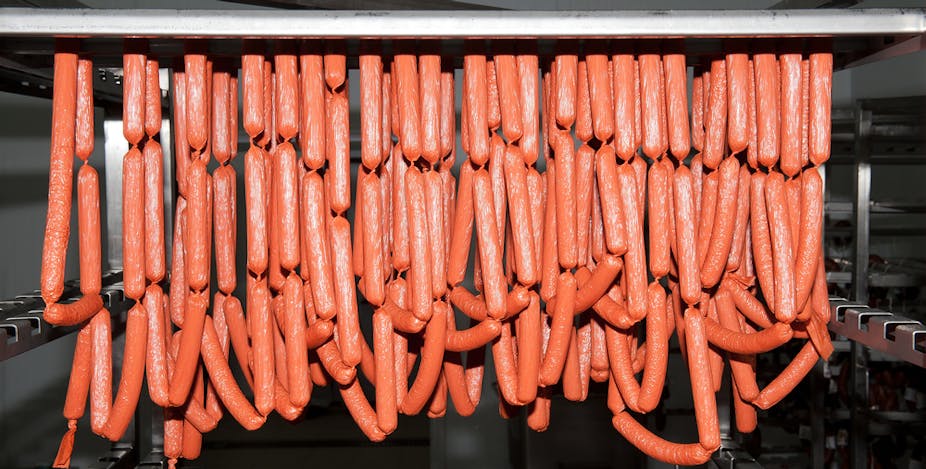The evidence that smoking causes lung cancer is definitive. It took a few decades, but cigarette packs now carry prominent health warnings to alert us to this risk.
When it comes to dietary patterns, convincing evidence collated by the World Cancer Research Fund also shows that regular consumption of some foods and drinks increases the risk for specific cancers.
It’s time to begin making consumers aware of the cancer risk associated with regular consumption of particular foods and drinks, through front-of-pack warning labels.
Snapshot of cancer in Australia
It is true that the absolute risk of developing cancer is low. Last year around 120,000 new cases of cancer were diagnosed in Australia, from a population close to 23 million.
But put another way, before the age of 75 your lifetime risk of being diagnosed with cancer is one in three for males and one in four for females. Cancer is now the leading cause of disease and injury in Australia, accounting for the loss of over 550,000 years of life due to ill health, disability or early death.
The most commonly diagnosed cancers last year were prostate (18,560 cases), bowel (15,840 cases), breast (14,680 cases), melanoma (12,510 cases) and lung cancer (11,280 cases). Many of these have good treatments outcomes but approximately 117 people still die from cancer each day.
The good news is that between 1982 to 2010, the five-year relative survival after a cancer diagnosis increased for the three most commonly diagnosed cancers: from 58% to 92% for prostate cancer, 48% to 66% for bowel cancer and from 72% to 89% in women with breast cancer.
But more could be done to prevent the development of cancer in the first place, or to reduce the risk of it recurring.
So, what foods and drinks increase cancer risk?
There is convincing evidence that alcohol increases the risk of pre- and post-menopausal breast cancer, and cancers of the mouth, throat and (in men) bowel. While the official recommendation is to limit alcoholic drinks to no more than two a day for men and one a day for women, when it comes to breast cancer risk there is no safe level of intake.
There is also convincing evidence that eating more than 500 grams of cooked meat per week is risky. For every 100 gram increase in red meat a day there is a 17% increase in bowel cancer risk.
For processed meat, there appears to be no completely safe level of intake, with a meta-analysis of 13 studies finding an 18% increase in bowel cancer risk for every 50-gram increase in daily intake.

The evidence indicates that salty and salt-preserved foods are probable causes of stomach cancer. As a result, the World Cancer Research Fund recommends avoiding these foods, not using salt when preserving foods, limiting consumption of processed foods with added salt and aiming for a low salt intake (less than six grams of salt or 2.4g of sodium) a day.
On the flip side, there is probable evidence that you can reduce your risk of bowel cancer by regularly eating garlic and foods high in dietary fibre, such as wholegrains, legumes, pulses, high-fibre cereals, vegetables and fruit. In fact, for every ten grams of fibre you consume per day, your risk reduces by 10%.
Eating plenty of non-starchy vegetables and fruits is associated with lower risk of cancers of the mouth, throat, oesophagus and stomach; while foods high in folate, such as green leafy vegetables, legumes, seeds, citrus fruits and fortified breads and cereals, are associated with lower risk of pancreatic cancer and diets high in calcium with lower risk of bowel cancer.
How would a labelling system work?
The food labelling process could be managed by Food Standards Australia and New Zealand (FSANZ) in the same way it currently manages health claims, which are voluntary statements made by food companies that refer to a relationship between food and health.
In January, FSANZ introduced a new standard to regulate health claims made on food labels or in advertisements. Two types of claims are now permitted: general and high-level claims.
General level health claims refer to something “in” the food and its effect on a health function, such as “calcium is good for bones”. A high-level health claim refers to something “in” the food and its relationship to a serious medical condition or an intermediate factor or risk marker for that medical condition. For example:

Diets containing a high amount of both fruit and vegetables reduce risk of coronary heart disease.
There are 13 pre-approved high level health claim statements and 200 pre-approved general health claim statements related to foods, their health effects, and health conditions in the FSANZ code. But none of these raise the alarm for consumption patterns associated with increased disease risk.
What we need is a similar list of statements to alert consumers to potential adverse risk from consumption. These claims could be made by public health authorities relating food consumption patterns to cancer risk.
This process could be overseen by the National Health and Medical Research Council (NHMRC) which currently produces Australia’s official dietary guidelines. The NHMRC could draw on the World Cancer Research Fund’s data in areas where there is convincing evidence that foods or drinks raise the risk of specific cancers.
Government health departments and non-government agencies such as cancer councils could also be approved to submit high-level health claims for foods and beverages where there is strong evidence that consumption increases risk.
It’s time to raise awareness about what consumers can safely eat and drink, and which foods to increase or avoid to lower their cancer risk. FSANZ high-level health claims on food labels could be one such signpost.

